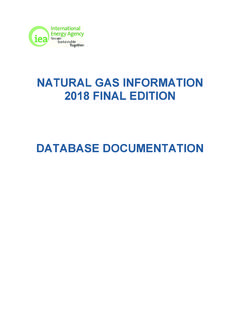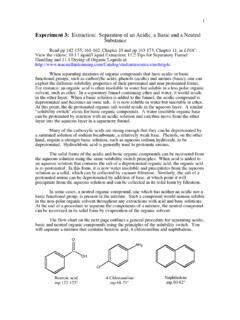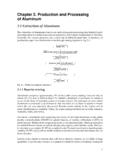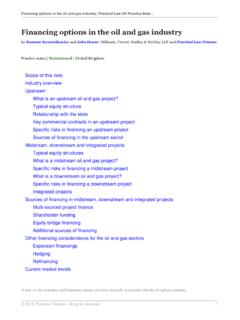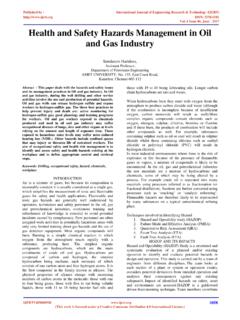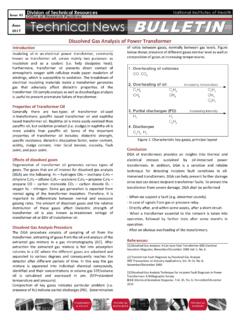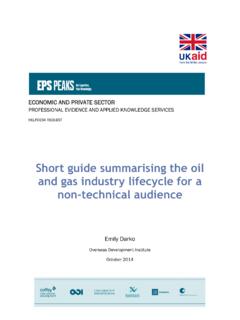Transcription of OSHA NIOSH Hazard Alert - Health and Safety Risks for ...
1 11-800-321-OSHA (6742) (1-800-232-4636) and Safety Risks for Workers Involved in Manual Tank Gauging and Sampling at Oil and Gas extraction SitesThe National Institute for Occupational Safety and Health ( NIOSH ) and the Occupational Safety and Health Administration (OSHA) have identified Health and Safety Risks to workers who manually gauge or sample fluids on production and flowback tanks from exposure to hydrocarbon gases and vapors, exposure to oxygen-deficient atmospheres, and the potential for fires and Workers at oil and gas extraction sites could be exposed to hydrocarbon gases and vapors, oxygen-deficient atmospheres, and fires and explosions when they open tank hatches to manually gauge or collect fluid samples on production, flowback, or other tanks ( , drip pots) that contain process fluids.
2 Opening tank hatches, often referred to as thief hatches, can result in the release of high concentrations of hydrocarbon gases and vapors. These exposures can have immediate Health effects, including loss of consciousness and death. Recent NIOSH and OSHA research showed that workers could be exposed to hydrocarbon gases and vapors when they work on or near production and flowback tanks. This means workers can face significant Health and Safety Risks when they manually gauge or sample tanks [Esswein et al. 2014; Jordan 2015]. These Risks are in addition to the risk of exposure to hydrogen sulfide (H2S), a well-recognized chemical exposure Hazard for those who work in the oil and gas extraction and production industry [OSHA].
3 NIOSH and OSHA also identified nine worker fatalities that occurred while workers manually gauged or sampled production tanks from 2010 2014 [ NIOSH 2015]. Exposures to hydrocarbon gases and vapors and/or oxygen-deficient atmospheres are believed to be primary or contributory factors to the workers deaths [Harrison et al. 2016]. Working on or near oil and gas production tanks is of particular concern because these tanks may contain concentrated hydrocarbon gases and vapors that are under pressure. When the thief hatch is opened, the release of these pressurized gases and vapors can expose workers. Second, the gases and vapors can displace oxygen, creating an oxygen-deficient environment.
4 Third, the hydrocarbon gas and vapor concentrations can exceed 10% of the lower explosive limit (LEL), creating a chance for fires and explosions. Exposure to hazardous atmospheres and fire/explosion Risks will vary depending on tank contents and operating conditions, the presence of ignition sources, and other factors (Box 1, page 3). What s in this Alert ? This Hazard Alert describes the Safety and Health hazards when workers manually gauge or sample fluids from production, flowback, or other tanks. It recommends ways to protect workers by eliminating or reducing exposures to hazardous atmospheres, and actions employers should take to ensure that workers are properly aware of the hazards and protected from exposure to hydrocarbon gases and vapors.
5 This Alert is a supplement to the OSHA Alliance Tank Hazard Alert released in 2015 [National STEPS Network 2015].A worker collecting a sample from the open hatch of a production tank. Image: Danni, (6742) (1-800-232-4636) Gas and Vapor Release from Production and Flowback TanksPetroleum hydrocarbons can exist as liquids, gases, and vapors. Production liquids ( , crude oil and condensate) at oil and gas extraction sites can release dissolved hydrocarbon gases such as methane, ethane, propane, and butane. Production liquids also evaporate to produce vapors such as pentane, hexane, benzene, and xylene. Hydrocarbon gases and vapors are often referred to as volatile organic compounds, or VOCs.
6 Hydrocarbon gases contained in crude oil are readily released into the air at ambient temperature and pressure. When a thief hatch is opened, substantial amounts of hydrocarbon gas and vapor (>100,000 parts per million) can be released [Jordan 2015], and in some cases this release can continue even after the initial headspace pressure is released. Furthermore, the composition of hydrocarbons in crude oil is complex, and the relative concentrations of specific gases and vapors are highly variable. When a worker opens a tank, the worker s breathing zone can immediately become an acutely toxic mix of concentrated hydrocarbon gases and vapors. Depending on weather conditions, the plume may disperse or engulf workers atop and around tank A shows how hydrocarbon gases and vapors behave when they are released from a production tank.
7 Appendix B lists exposure limits for common hydrocarbon gases and Hazards of Hydrocarbon Gases and VaporsAcute exposures to hydrocarbon gases and vapors can affect the eyes, lungs, and central nervous system. If present in sufficient concentrations to displace oxygen, this exposure can sensitize the heart to stress hormones, such as catecholamines, causing abnormal rhythms and ventricular fibrillation that can lead to sudden death [Adgey et al. 1995; Bass 1970; Martinez et al. 2012; NIOSH 2005a,b,c; Poklis 1976; Reinhardt et al. 1971; Riihim ki and Savolainen 1980]. Even a brief exposure (30 seconds or less) to high concentrations of hydrocarbons and a low-oxygen atmosphere can result in the rapid onset of respiratory depression, hypoxia, and fatal cardiac arrhythmias [Miller and Mazur 1984].
8 Pre-existing coronary artery disease may exacerbate the risk. These exposures can also have narcotic effects, causing dizziness, rapid disorientation, and confusion that could lead to loss of judgment, narcosis, and incapacitation [Drummond 1993; Sugie et al. 2004]. Some hydrocarbons are also known carcinogens ( , benzene) [ATSDR 2007].Forward-looking infrared (FLIR) photograph of the initial hydrocarbon plume after a thief hatch on a production tank battery is opened. The plume later expands to many times its initial size. Image: John Snawder, worker manually gauges a flowback tank. The thief hatch is directly in front of his feet, and the gas and vapor released is invisible. Image: Max Kiefer, (6742) (1-800-232-4636) that may increase worker exposure to hydrocarbon gases and vapors and flammable atmospheres1.
9 Produced Fluid and Reservoir Characteristics Condensate and lighter crude (versus heavy crude) Unstabilized (non-degassed) crude oils High gas to oil ratio fluids High temperature fluids High production volumes/early in production 2. Operational and Task-related Factors Drilling out plugs during completion operations Tanks that are not isolated prior to opening hatch Interconnected tanks (tank batteries) Tanks using flare systems with backpressure on the vapor space Flowback operations Working around tanks with vapor recovery units Maintenance work Working around separators/enclosed spaces3. Environmental Factors Higher temperatures Weather inversions Higher altitude Low wind speed Factors that may decrease worker exposure to hydrocarbon gases and vapors and flammable atmospheres1.
10 Engineering Controls Remote or automatic gauging and sampling Blowdown valves Tank sampling taps Thief hatch pressure indicators, etc. 2. Work Practices Working upwind and at a distance from open hatches3. Personal Protective Equipment (PPE) Flame retardant clothing Appropriate respiratory protection Impermeable gloves41-800-321-OSHA (6742) (1-800-232-4636) Fatalities during Manual Tank Gauging and Fluid Sample Collection, 2010 2014 NIOSH researchers, OSHA officials, and academic occupational Health researchers investigated reports of worker deaths from 2010 through 2014 associated with manual tank gauging and the collection of fluid samples (Appendix C). During the 5-year period, NIOSH researchers identified nine fatalities involving these tasks.










